Introduction
Social Pragmatic Disorder, also known as Social Communication Disorder (SCD), presents significant challenges in using verbal and nonverbal communication for social purposes. Individuals with SCD struggle with understanding social cues, nuances of conversation, and interpreting nonliteral language components such as metaphors and idioms. While often associated with autism spectrum disorder (ASD), SCD can also occur independently.
The underlying factors contributing to these difficulties are still being explored, with theories including Theory of Mind and language deficits. Early intervention is crucial, as timely support and tailored interventions can help individuals with SCD develop the necessary skills for social interactions and establish fulfilling relationships. Diagnosis requires a meticulous evaluation by professionals specializing in developmental health.
Understanding and treating SCD has evolved significantly, with evidence-based treatment approaches such as the Social Thinking® framework and Carol Gray's Social Stories™ proving effective. Visual supports, real-world practice, fostering empathy, and incorporating technology are key strategies for improving pragmatic language skills and enhancing social communication. The journey towards better communication and social interaction involves a team of dedicated professionals, including speech-language pathologists, occupational therapists, and psychologists.
Additionally, a wealth of resources, support groups, and online platforms offer guidance and foster connections among individuals and their caregivers. With ongoing advancements in the field of mental health, there is a growing recognition of the importance of supporting individuals with Social Pragmatic Disorder, ensuring that they have the tools and resources needed to thrive in their social environments.
Understanding Social Pragmatic Disorder
Social Pragmatic Disorder, also recognized as Social Communication Disorder (SCD), is a neurodevelopmental condition marked by significant challenges in using both verbal and nonverbal communication for social purposes. This includes difficulties in understanding and appropriately responding to social cues and the nuances of conversation. While SCD is often associated with autism spectrum disorder (ASD), it can also occur independently.
Understanding metaphors, similes, idioms, and humor comprises a fundamental aspect of social communication, yet for individuals with ASD, grasping these nonliteral language components can be particularly challenging. Research indicates that while typically developing children acquire these skills early on, autistic children often experience a delayed progression in pragmatic language abilities, including the interpretation of figurative speech. This slower rate of development can result in a literal interpretation of expressions meant to convey more subtle or indirect meanings.
The intricacies of social communication in ASD may stem from various underlying factors. Some studies suggest that the social communication difficulties are linked to Theory of Mind (ToM), which involves the ability to understand the mental states of oneself and others. However, this view is not universally accepted. Alternative theories propose that the challenges may arise from more fundamental language deficits, such as morphosyntax and vocabulary.
Emerging neuroimaging research further contributes to our understanding of SCD in the context of ASD, exploring the neural correlates of the social communication challenges. Additionally, reframing the narrative around autism, recent discussions in the scientific community highlight the unique strengths and potential advantages that autistic individuals may possess, particularly in situations requiring ethical judgment or resistance to peer influence.
For those supporting individuals with ASD, recognizing the diversity of language processing and social communication experiences is crucial. It encourages a more nuanced approach to interventions and underscores the importance of tailored support that respects the individual's learning pace and style.
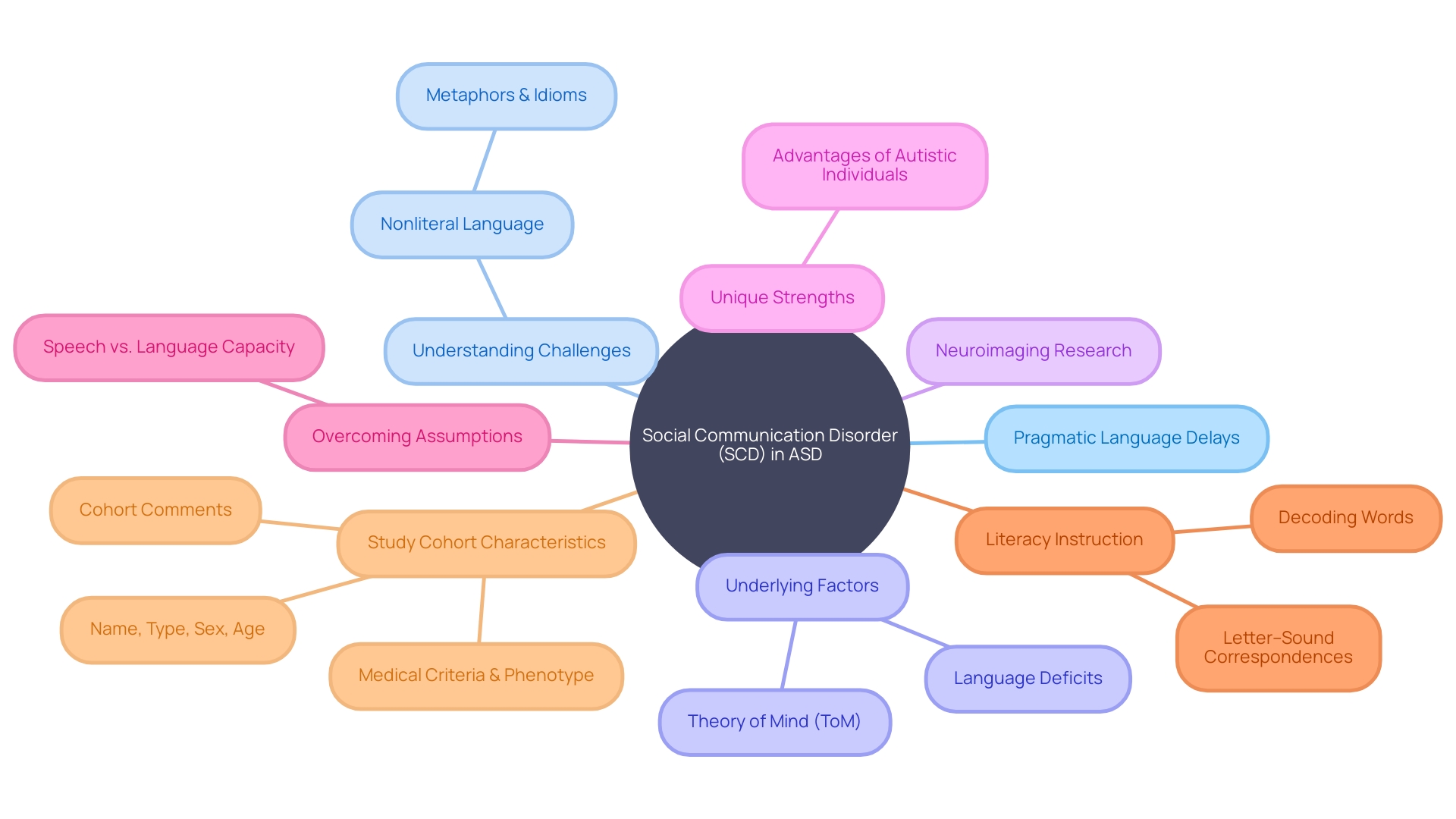
Symptoms and Characteristics
Children with Social Pragmatic Disorder navigate a complex array of challenges that can deeply affect their social interactions and relationships. They often find it difficult to start or keep a conversation going and may not use eye contact and body language effectively. Interpreting humor, sarcasm, and non-literal language can be especially challenging, as can adjusting their way of communicating to fit different social contexts. Understanding others' feelings and viewpoints doesn't come easily to these children, which can lead to struggles with taking turns in conversation, sharing their own experiences, and forming meaningful connections. With such a significant impact on their social functioning, it's vital to recognize and address these difficulties early on.
Empathy, the ability to share and understand others' emotions, is a concept that children with Social Pragmatic Disorder often struggle with. When we think about empathy, we recognize that it's a key component of healthy social interactions, as it allows us to connect with the experiences and emotions of those around us. However, for children with this disorder, empathizing with others can be a complex task that requires guidance and support.
The rising number of children referred to mental health services for anxiety, which has seen a substantial increase in recent years, indicates a growing need for awareness and resources. As Laura Bunt of YoungMinds pointed out, the surge in mental health challenges among the youth is a pressing social issue that demands attention. The absence of adequate support can have a profound impact not only on the individual children and their families but also on society as a whole.
Moreover, the latest research and developments in psychiatry, such as the updates to the ICD-11 classification, show a continuous effort to improve our understanding and treatment of mental health conditions. Insights from studies on human brain organoids and their ethical implications further emphasize the importance of navigating the intricacies of mental health with both care and innovation.
Understanding the nuances of conditions like Social Pragmatic Disorder is crucial for parents, educators, and mental health professionals. It's not just about recognizing the symptoms but also providing the appropriate support to help these children thrive in their social environments. With the right interventions and understanding, we can help them develop the skills they need to establish fulfilling relationships and lead happier, more connected lives.
Diagnosis and Assessment
The process of pinpointing Social Pragmatic Disorder requires a meticulous evaluation by professionals who specialize in developmental health, such as speech-language pathologists or developmental pediatricians. This evaluation encompasses a detailed examination of the person's developmental milestones, direct observation of their social interaction abilities, discussions with family and those close to the person, and the administration of standardized tools that measure communicative and social aptitude. Such a comprehensive assessment is pivotal, not only to ensure an accurate diagnosis but also to guide effective intervention plans tailored to the individual's needs.
For instance, in a scenario reflective of the meticulous approach required, healthcare professionals might use a systematic process similar to the 'digital-assurance process' implemented by the NHS for adopting new technologies. This process includes an initial assessment to verify the security and appropriateness of the technology. Similarly, in diagnosing Social Pragmatic Disorder, clinicians gather extensive information to rule out overlapping conditions and confirm the diagnosis.
In light of recent research and advances in the field, it's clear that understanding and treating mental health conditions have evolved significantly. According to BMC Psychiatry, the updated ICD-11 classification may offer improved pathways for diagnosis and treatment. Furthermore, the importance of early intervention is underscored by findings suggesting that timely treatment can lead to better outcomes. This parallels the approach taken for Social Pragmatic Disorder, where early, accurate identification and intervention are crucial for effective management and support.

Importance of Early Intervention
For children experiencing Social Pragmatic Disorder, early intervention is not simply beneficial; it is a transformative force that fosters social communication development. The sooner we can provide assistance, the better the prospects for these children to hone their social skills, surmount communication hurdles, and lead fulfilling lives. Tailored approaches are essential, often encompassing personalized therapies, social skills workshops, and interventions pinpointing particular challenges. The adolescent years, marked by complex social interactions and reliance on various communication technologies, can be particularly trying for those with Social Pragmatic Disorder. However, with early and appropriate support, these individuals can learn to navigate these complexities and form significant social bonds. Studies highlight the indispensable role of mental health in the early stages of life, suggesting that addressing these needs at the earliest suspicion of a problem can profoundly influence a child's emotional and social trajectory. By focusing on building the capacity of adults in children's lives to understand and support their development, we lay a strong foundation for their future. This approach is corroborated by research, indicating that when teachers, families, and other key figures collaborate, it leads to improved social skills, emotional functioning, and a reduction in behavioral challenges. The significance of timely and effective interventions is echoed in recent discussions at mental health conferences, emphasizing the need to translate research into practice, particularly in diverse and underserved communities. As we strive for impactful change, it's crucial to ensure that all children have access to the interventions that can set them on the path to success.

Communication Therapy and Treatment
Enhancing communication skills in individuals with Social Pragmatic Disorder is a multifaceted endeavor that therapists approach with a blend of evidence-based techniques tailored to each person's unique needs. By focusing on both verbal and nonverbal communication, therapists help individuals navigate the complexities of social interaction. This includes interpreting social cues and understanding the subtleties of context, as well as fostering the ability to see situations from others' perspectives—a skill known as perspective-taking.
Role-playing, structured activities, and the use of social stories are among the dynamic tools therapists employ to engage individuals in the learning process. Video modeling also serves as an effective teaching aid, allowing individuals to observe and replicate appropriate social behaviors in a controlled environment. The overarching goal of these interventions is not only to teach specific pragmatic language skills but also to ensure the generalization of these skills to various social settings.
Research underscores the importance of such targeted communication strategies. For example, a study involving general practitioners revealed how excessive talkativeness in patients, characterized by a lack of focus and an overload of irrelevant information, can hinder effective communication. By applying structured interventions, similar to those used in communication therapy, the practitioners were able to manage the conversation more effectively. This highlights the potential for structured communication strategies to enhance clarity and focus in individuals with communication challenges.
Furthermore, current psychiatric research, as outlined by BMC Psychiatry and other scholarly sources, continues to evolve, offering new insights into the diagnosis and treatment of mental health conditions. This advancing knowledge base informs the therapeutic approaches for Social Pragmatic Disorder, ensuring that interventions remain current and evidence-based. Thus, as therapists draw on these evolving strategies, they help individuals with Social Pragmatic Disorder to develop the communication skills necessary for richer social interactions and improved quality of life.
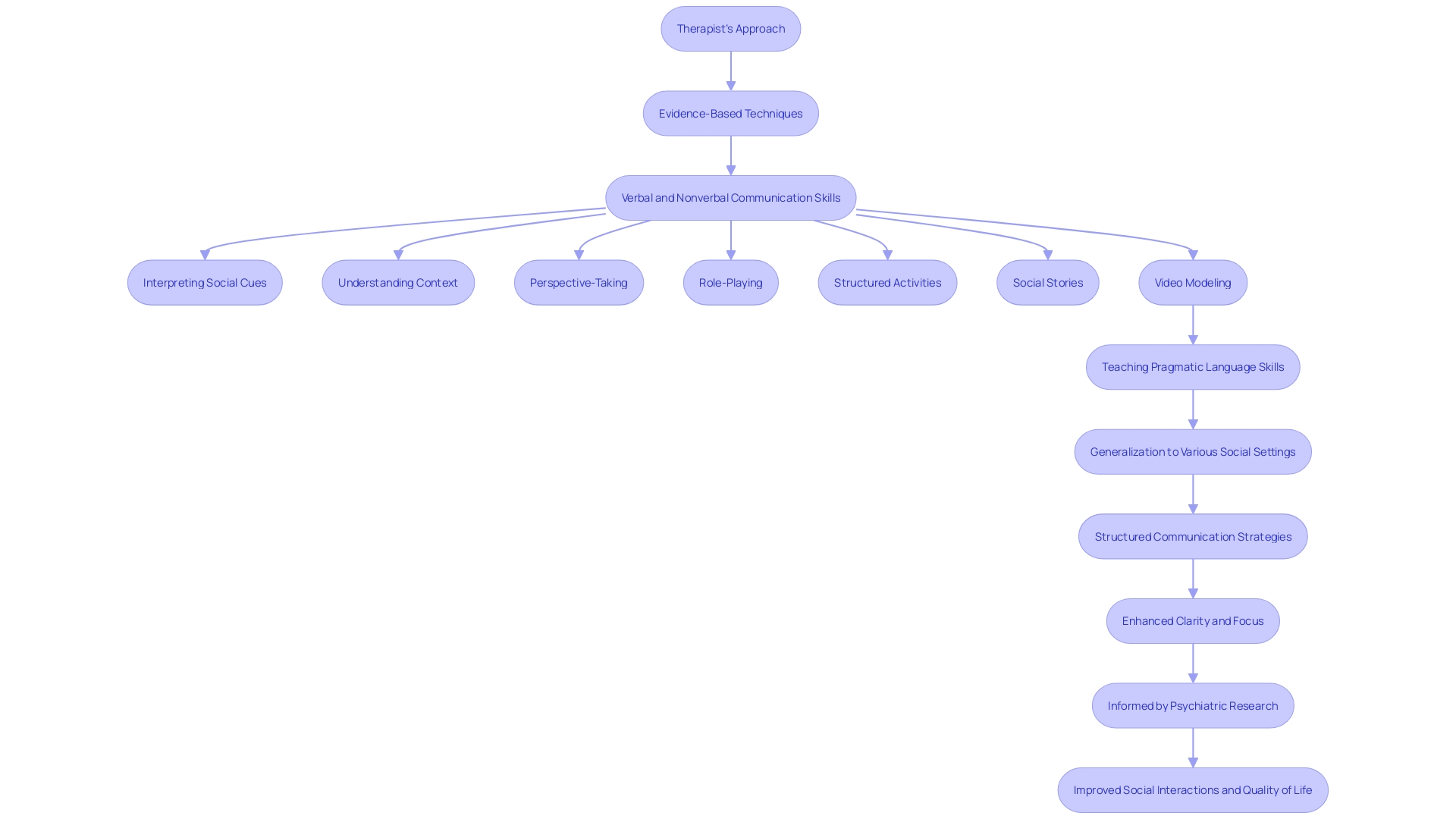
Strategies for Supporting Children
Supporting children with Social Pragmatic Disorder requires a nuanced approach that integrates both structured strategies and empathetic understanding. One effective method is to establish a structured and predictable environment, which can alleviate anxiety and bolster social interactions. This means creating a consistent routine with clear expectations that children can rely on.
Additionally, visual supports can be a lifeline in navigating social complexities. Tools such as social scripts, visual schedules, and cue cards can serve as tangible guides for children to follow in social scenarios, helping them process and engage more effectively.
Peer interactions are equally vital; they provide a safe space for children to hone their social skills. By facilitating these interactions, children are given the chance to practice and refine their abilities in a supportive environment, which can be especially beneficial for their growth and confidence.
Empathy and understanding are cornerstones of social development. Teaching children about varying perspectives, emotions, and social norms can greatly enhance their ability to connect and empathize with others. This not only supports their social interactions but also nurtures their emotional intelligence.
Lastly, the power of positive reinforcement cannot be overstated. Acknowledging and reinforcing positive social behaviors motivates children to continue these practices and aids in their social development. It's a simple yet profound way to encourage progress and build social confidence.
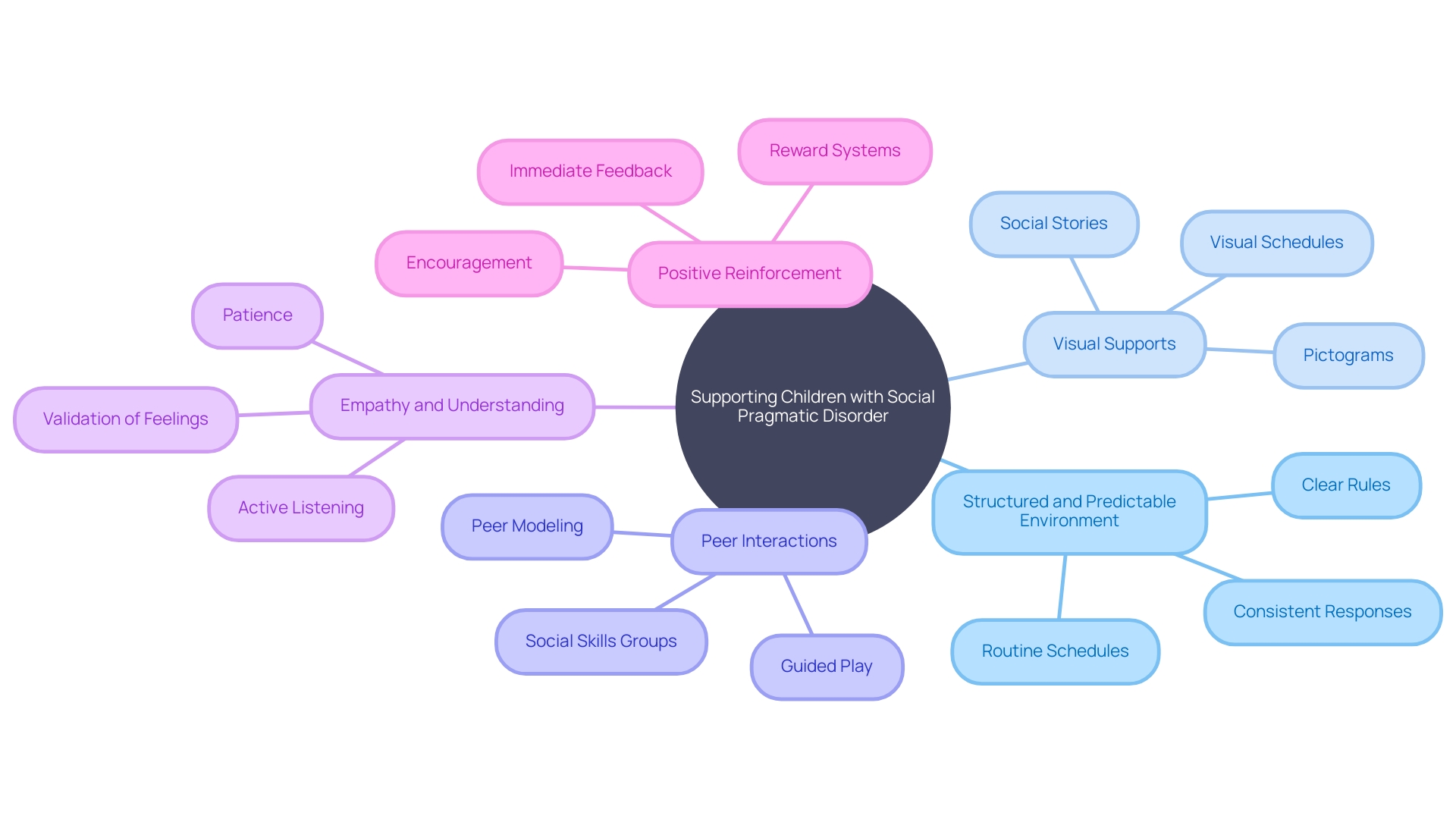
Role of Visual Supports
Visual supports serve as a transformative resource for individuals grappling with Social Pragmatic Disorder, offering a visual framework to decode the complexities of social interactions. These visual aids, ranging from schedules and social narratives to cue cards and reminders of social norms, act as crucial scaffolds. They empower individuals to interpret social cues more effectively and engage in social exchanges with increased understanding and confidence. For instance, the strategic use of visual schedules can alleviate the anxiety associated with unpredictable social scenarios, while social stories can elucidate the nuances of interpersonal communication. By integrating these visual supports into their daily lives, individuals with Social Pragmatic Disorder gain a visual vocabulary that bridges the gap between social expectations and personal comprehension, fostering a more connected and interactive social experience.
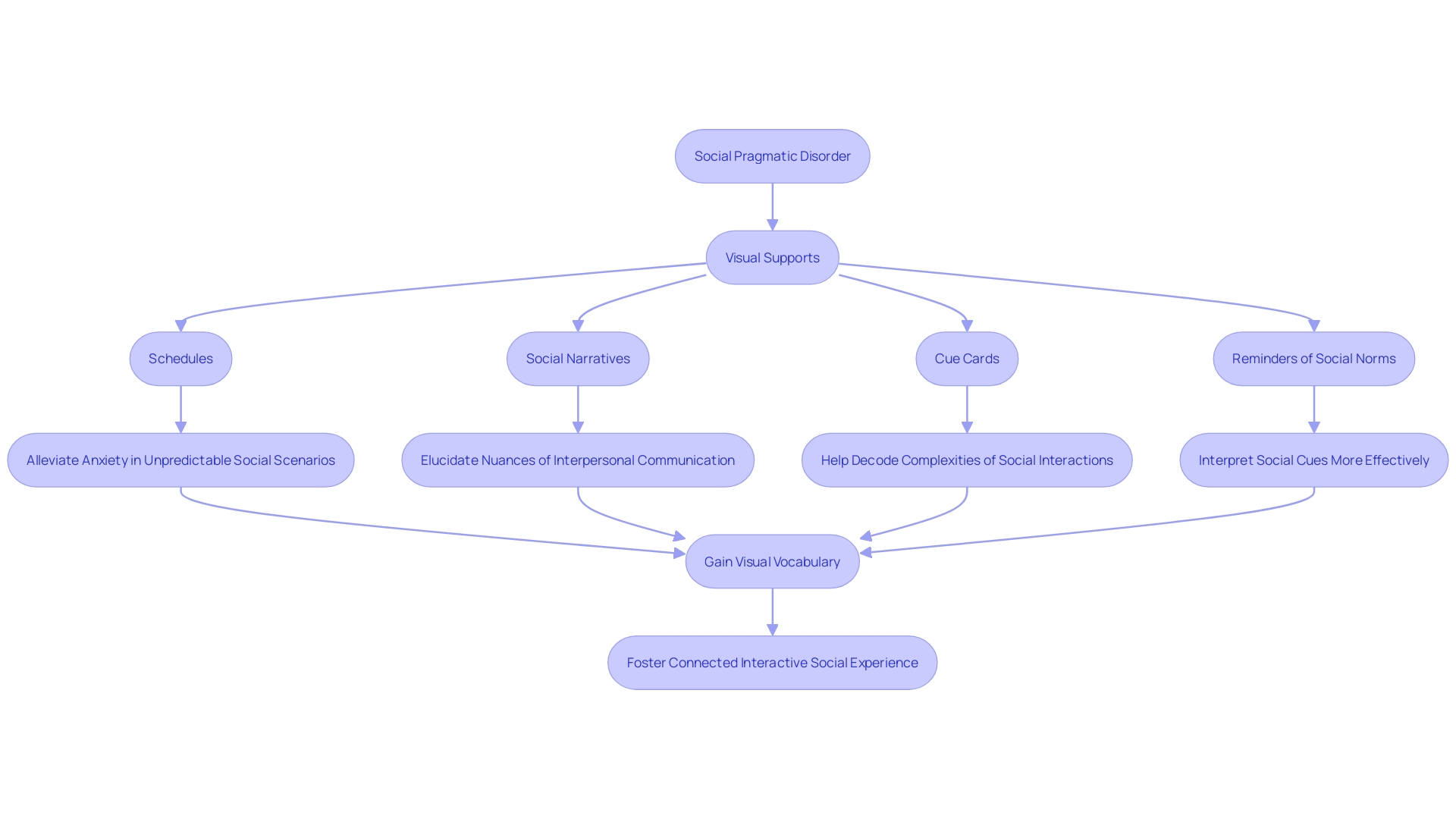
Encouraging Practice in Social Settings
Real-world engagement is essential for individuals with Social Pragmatic Disorder to effectively transfer their learned social skills to various situations. Activities like joining clubs or attending community gatherings provide invaluable opportunities for these individuals to practice communication strategies in a natural environment. With the right support and encouragement during such interactions, they can grow in confidence and become more adept in social settings.
The importance of this practice is underscored by insights from Howard Gardner, a developmental psychologist at Harvard University, who identified interpersonal intelligence as one of the multiple intelligences essential for human connection. As Gardner suggests, we can enhance our interpersonal skills through dedicated effort and practice.
Recent studies also stress the importance of recognizing and supporting the unique challenges faced by neurodivergent individuals, such as those with ADHD and Autism Spectrum Disorder, in environments like the workplace. By appreciating and nurturing their distinct abilities, we can create more inclusive spaces that allow for personal and professional growth.
Moreover, real-life application of social skills is not only beneficial for personal development but also for broader societal interactions. The OECD notes that social and emotional skills are increasingly acknowledged as crucial for students' educational and life outcomes.
In light of this, encouraging participation in varied social contexts not only fosters individual growth but also contributes to a more understanding and inclusive society, where the value of diverse interpersonal abilities is recognized and celebrated.
Fostering Empathy and Understanding
Fostering empathy and the ability to understand others is critical in enhancing social communication for those with Social Pragmatic Disorder. By engaging in discussions that highlight emotions, viewpoints, and various social contexts, individuals can gain a more profound comprehension of others' experiences. Utilizing techniques like looping, where one paraphrases and inquires for clarification, can significantly enhance perspective-taking. Additionally, incorporating real-world situations and role-playing can effectively demonstrate diverse social interactions, thereby cultivating empathy.
Recent studies, such as the collaboration between McGill and Albany University, underscore the importance of vividly imagining others' predicaments to evoke empathy and drive supportive actions. This research illustrates how mental simulations of distressing scenarios can amplify personal distress and foster prosocial behavior. In line with these findings, it's beneficial to encourage individuals to truly visualize themselves in others' circumstances to enhance empathetic connections.
During adolescence, a period marked by complex social changes, the development of communication skills across various platforms, including video chat, texting, and social media, becomes imperative. This stage also emphasizes the significance of self-reflection in fostering autonomy. By comprehending one's own thoughts and emotions, adolescents can engage more authentically with others and make decisions that resonate with their values.
Moreover, understanding that the interpretation of nonliteral language, such as metaphors and idioms, develops at a slower pace in autistic individuals, can inform targeted support strategies. Research has revealed that autistic children may interpret figurative expressions literally due to challenges in areas such as morphosyntax and vocabulary. This insight can guide the creation of interventions tailored to the unique linguistic needs of those with Social Pragmatic Disorder.
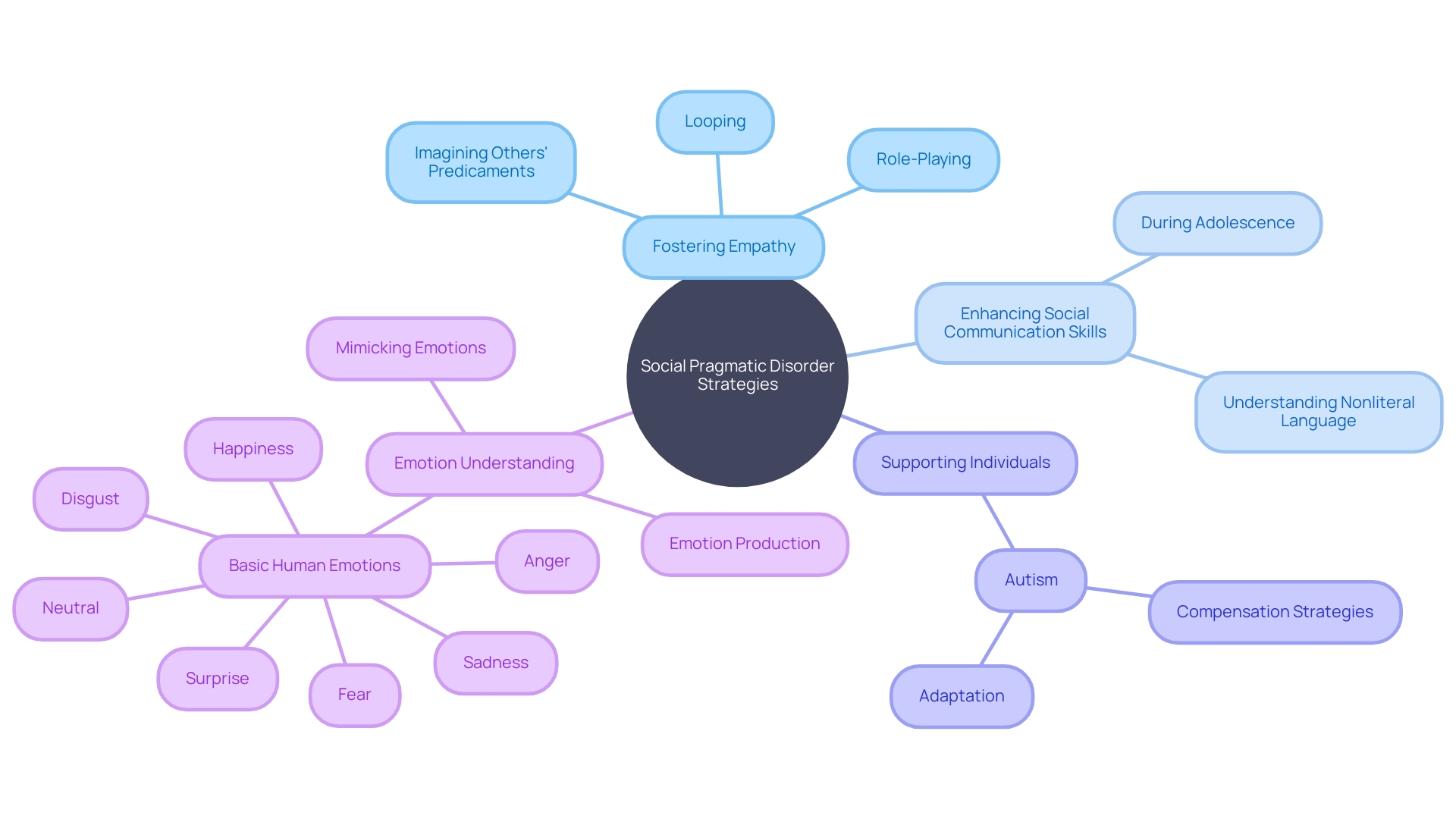
Evidence-Based Treatment Approaches
Understanding how to address Social Pragmatic Disorder is essential for enhancing the quality of life for those affected. Comprehensive treatment strategies such as Michelle Garcia Winner's Social Thinking® framework, which focuses on fostering social cognitive skills, have been instrumental. Carol Gray's Social Stories™ is another transformative approach that uses custom-made stories to improve social understanding among individuals with this condition. Moreover, the Hanen Program®, emphasizing parent involvement in speech therapy, and the Picture Exchange Communication System (PECS), which aids in developing communication skills, are also among the notable methodologies that have been empirically validated.
These approaches are grounded in the principle that effective communication and social interaction can be taught and improved through consistent practice and support. Emphasizing the importance of an individualized approach, these treatments cater to the unique needs of each person, ensuring that they can navigate social contexts with increased confidence and skill. By harnessing the power of evidence-based practices, individuals with Social Pragmatic Disorder can achieve significant progress in their social communication and pragmatic language abilities.
Strategies for Improving Pragmatic Language Skills
Pragmatic language skills are essential for navigating social interactions, and those with Social Pragmatic Disorder often find this challenging. Enhancing these skills can be transformative, and here's how to do it:
-
Emulate effective communication by showcasing the use of language in various social scenarios, such as how to greet someone, make requests, or participate in conversations. This modeling provides a clear example for them to follow.
-
Offer clear, step-by-step guidance on pragmatic language elements. By breaking down these skills into smaller parts and offering explicit teaching, individuals can practice and improve their abilities in a structured way.
-
Implement video modeling as a learning tool. By watching videos or engaging with social stories that illustrate proper language use, individuals can visualize and better understand the nuances of pragmatic language.
These strategies, grounded in research and practice, can make a significant impact on the lives of those struggling with pragmatic language skills. For instance, despite the common misconception that speech is the sole expression of language, individuals who are unable to speak, such as the deaf community, can effectively communicate through alternative means like sign language with proper instruction and support.
Moreover, it's crucial to recognize that about one-third of autistic children and adults face significant communication hurdles due to their inability to use speech effectively. In these cases, providing access to language-based alternatives can open up new educational, employment, and social opportunities that were previously out of reach.
Understanding the complexities of linguistic knowledge, as recent research suggests, involves recognizing that language learning is largely implicit. This highlights the importance of creating supportive environments that cater to the unique learning processes of individuals with Social Pragmatic Disorder.
By employing these proactive strategies, we can foster a more inclusive and communicative world where everyone has the opportunity to express themselves and connect with others.
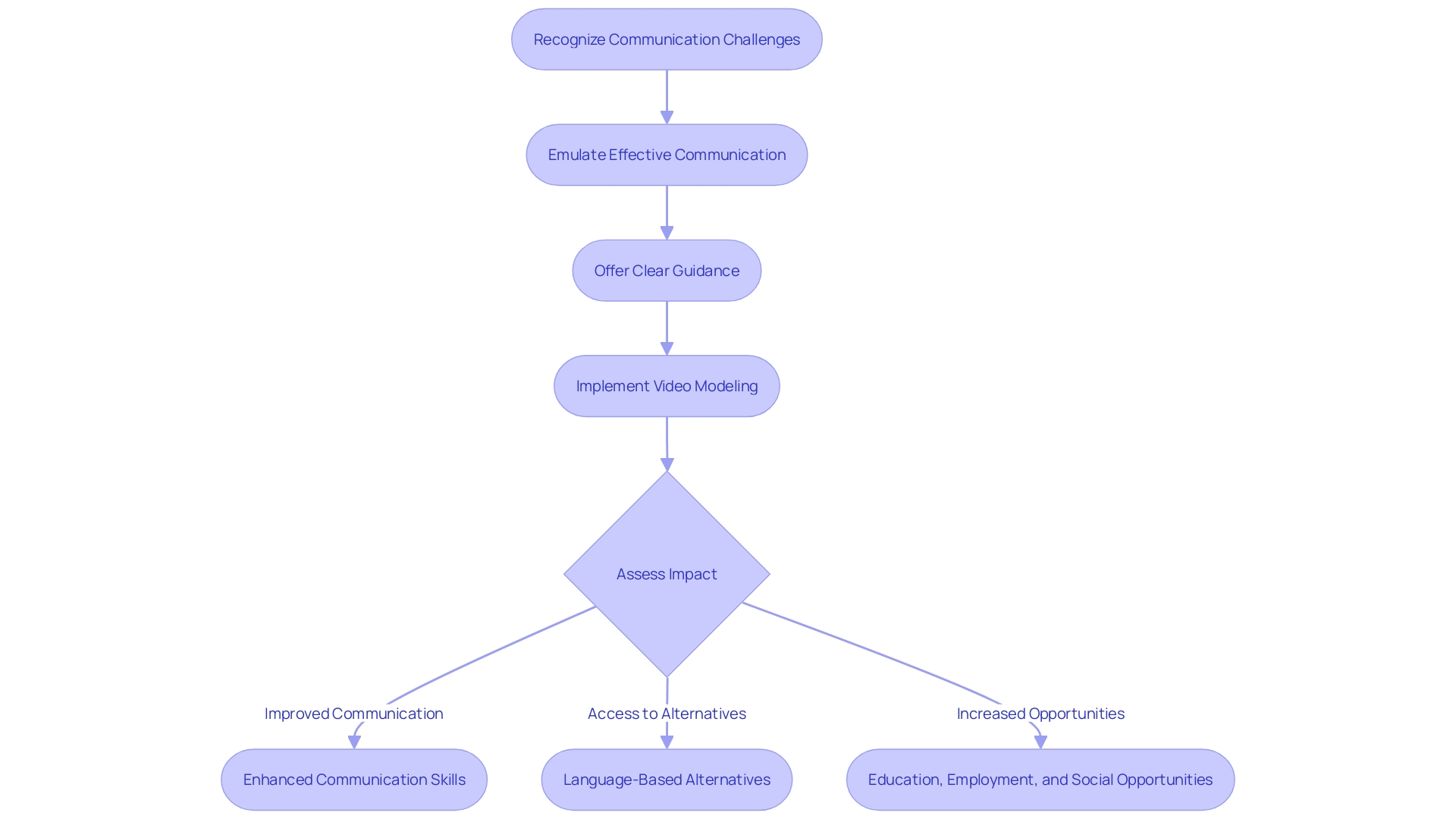
Incorporating Technology and Digital Tools
Leveraging technology in the realm of Social Pragmatic Disorder opens new avenues for enhancing social communication skills. Apps and digital platforms offer a range of interactive exercises, visual aids, and practice opportunities, all within an engaging, user-centric interface. For instance, the recent development of a "mental fitness system" utilizing virtual reality platforms demonstrates the potential of technology to bolster concentration and situational awareness—not just for athletes, but also for students with attention and social communication challenges.
Validating the efficacy of such digital tools, a comprehensive meta-analysis covering over 2,000 participants revealed a significant improvement in attention, executive function, and working memory among children diagnosed with ADHD. This underscores the potential benefits for those with Social Pragmatic Disorder. It's crucial to integrate technology thoughtfully, ensuring it aligns with and extends the benefits of existing intervention strategies.
Moreover, the emergence of new apps like the Roll Mobility App, which crowdsources data on accessible locations, reflects the growing trend of community-driven digital solutions. These tools not only empower individuals by providing valuable information but also foster a sense of community and shared experience.
In practice, introducing new technology requires a rigorous digital assurance process to ensure security, appropriateness, and compliance with standards. This structured approach, as implemented by healthcare trusts, ensures that any new digital interventions serve the best interests of the user and complement current practices. The story of Lil's transition to a new educational setting illustrates the thoughtful application of technology, easing the shift through digital storytelling that addresses the challenges of unfamiliar environments.
Given the expansive reach of social media, with over 5 billion users worldwide, these platforms too could play a critical role in disseminating information and connecting communities. The statistic that a typical social media user interacts with nearly 7 platforms shows the potential for these interventions to reach and engage a broad audience. As we embrace these promising developments, ensuring the privacy and well-being of individuals remains paramount, keeping the focus on enhancing lives through innovative digital assistance.
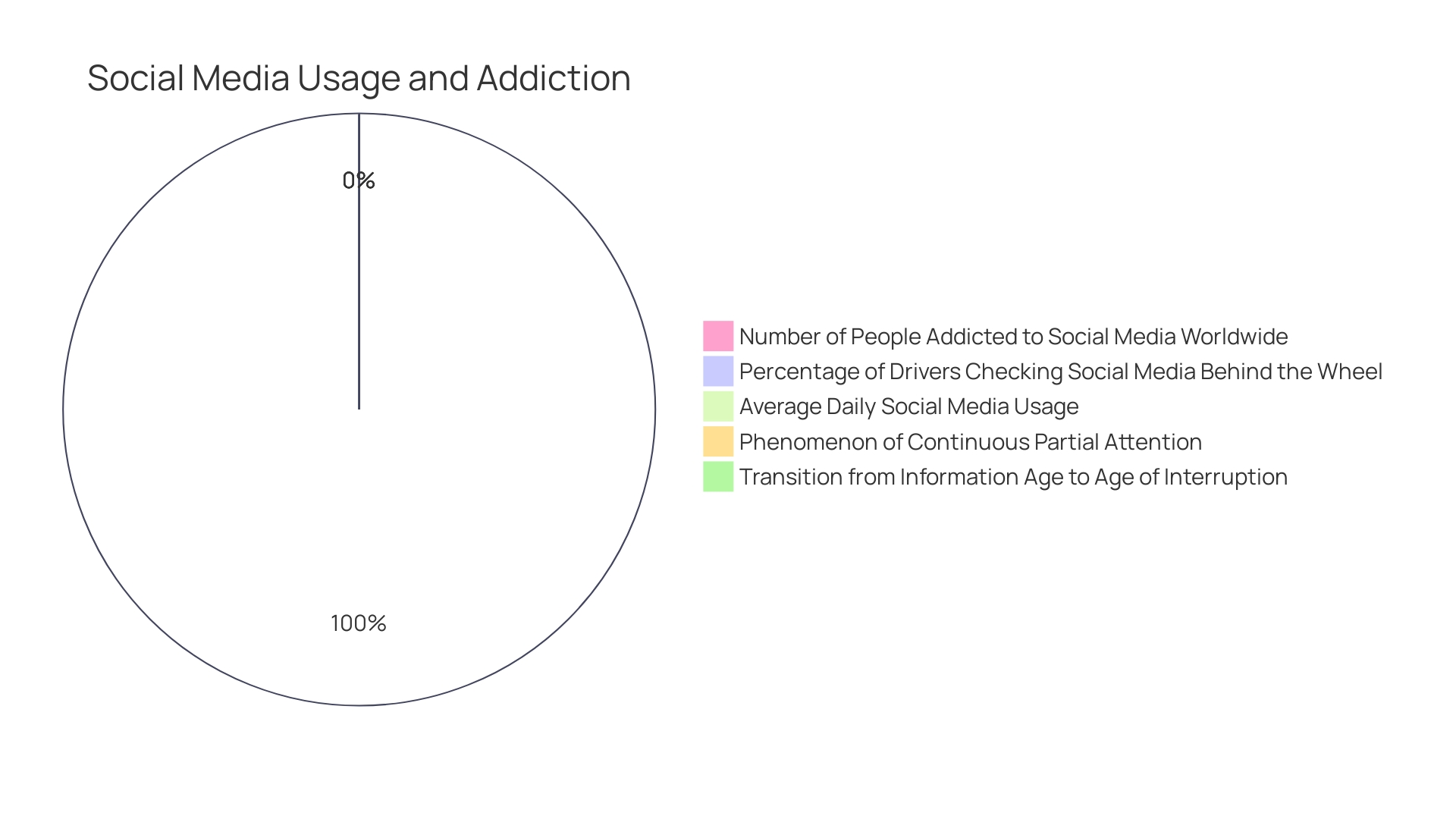
Professional Help and Resources
When it comes to Social Pragmatic Disorder, the journey to better communication and social interaction often involves a team of dedicated professionals. Speech-language pathologists are at the forefront of this effort, providing specialized assessments and therapy tailored to each individual's needs. Their expertise in social communication is invaluable for those facing challenges in understanding and using language in social contexts.
Occupational therapists also play a critical role in supporting individuals with Social Pragmatic Disorder. They offer strategies to manage sensory issues and improve motor skills, which can significantly enhance the ability to engage socially.
Psychologists with a focus on social communication contribute to a comprehensive approach to treatment. They delve into the psychological aspects of social interaction, helping individuals navigate the complex world of social cues and relationships.
For those seeking additional support, a wealth of resources is available. Books and online materials can be a treasure trove of information, while support groups provide a community of understanding and shared experiences. These resources not only offer guidance but also foster connections among parents, caregivers, and individuals with Social Pragmatic Disorder.
In the broader context of mental health, initiatives like the NAMI HelpLine offer a lifeline to those in need. With a simple text to 62640, individuals can connect with experienced HelpLine Specialists, ready to provide support, information, and resource referrals. This peer-support service demonstrates the power of community and the importance of accessible, accurate information in the realm of mental health.
The landscape of mental health support continues to evolve, with new platforms and services emerging to meet the needs of those affected. The commitment to exploring innovative approaches to care and support, as seen in the ongoing development of online mental health resources and the political drive for change, reflect a broader societal acknowledgment of the importance of mental well-being.
Ultimately, the message is clear: individuals with Social Pragmatic Disorder are not alone in their journey. Through the combined efforts of professionals, peer-support services, and a growing repository of resources, support is within reach, paving the way for improved communication and a more connected life.
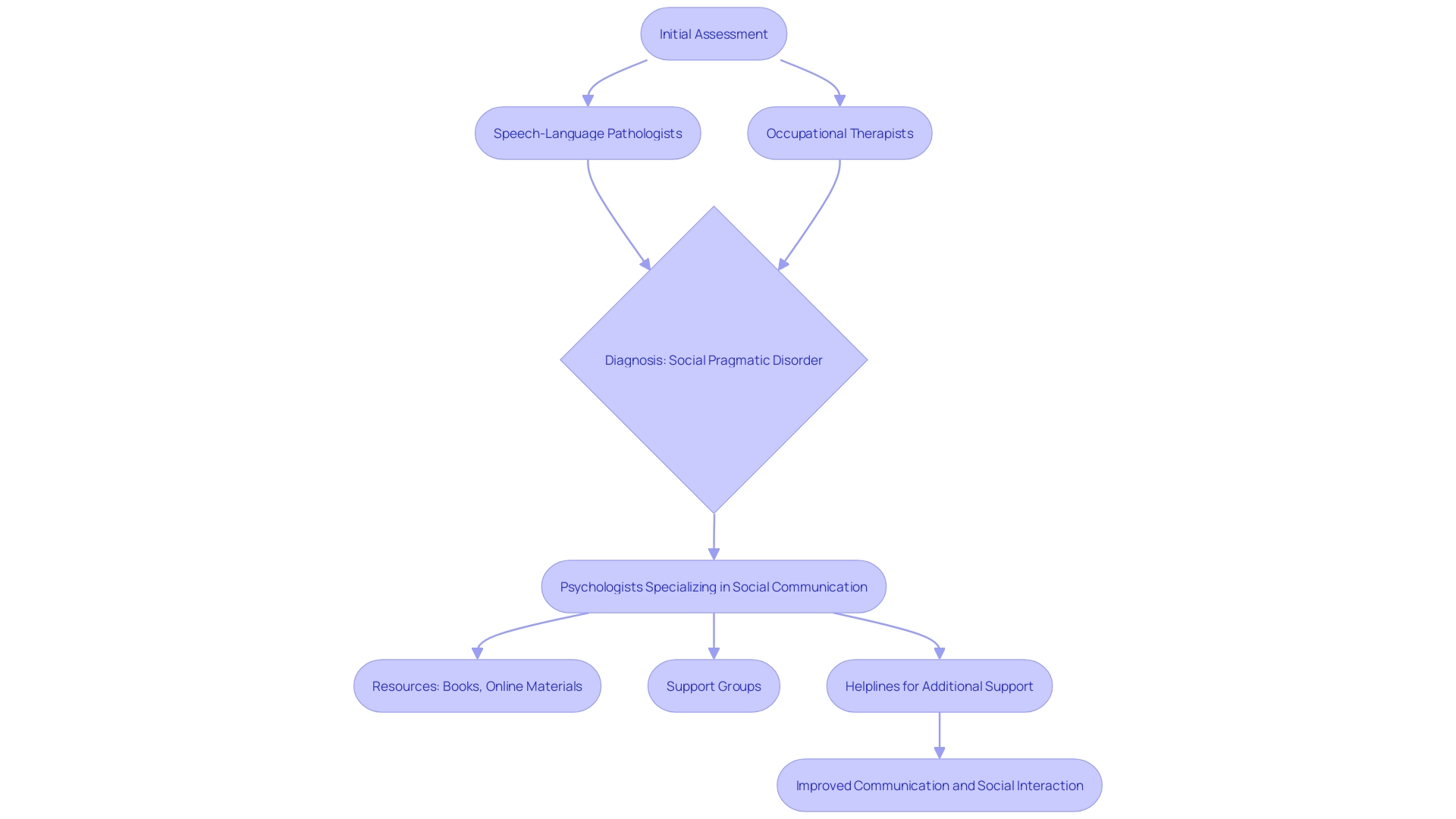
Conclusion
In conclusion, understanding and supporting individuals with Social Pragmatic Disorder is essential for their social development and overall well-being. Early intervention plays a crucial role in helping individuals with Social Pragmatic Disorder develop the necessary skills for social interactions and establish fulfilling relationships.
Diagnosing Social Pragmatic Disorder requires a meticulous evaluation by professionals specializing in developmental health. Evidence-based treatment approaches, such as the Social Thinking® framework and Carol Gray's Social Stories™, have proven effective in improving social communication skills.
Strategies for supporting children with Social Pragmatic Disorder involve creating a structured environment, using visual supports, facilitating peer interactions, fostering empathy and understanding, and providing positive reinforcement. Visual supports act as transformative resources, decoding the complexities of social interactions and empowering individuals to engage with increased understanding and confidence.
Real-world practice in social settings is crucial for individuals to transfer their learned social skills effectively. Fostering empathy and understanding is key in enhancing social communication, and integrating technology and digital tools offers new avenues for skill development.
A team of dedicated professionals, including speech-language pathologists, occupational therapists, and psychologists, plays a vital role in supporting individuals with Social Pragmatic Disorder. Resources, support groups, and online platforms offer guidance and foster connections among individuals and their caregivers.
By understanding and supporting individuals with Social Pragmatic Disorder, we can help them develop the necessary skills for social interactions and establish fulfilling relationships. Ongoing advancements in the field of mental health further emphasize the importance of providing individuals with Social Pragmatic Disorder the tools and resources needed to thrive in their social environments.




